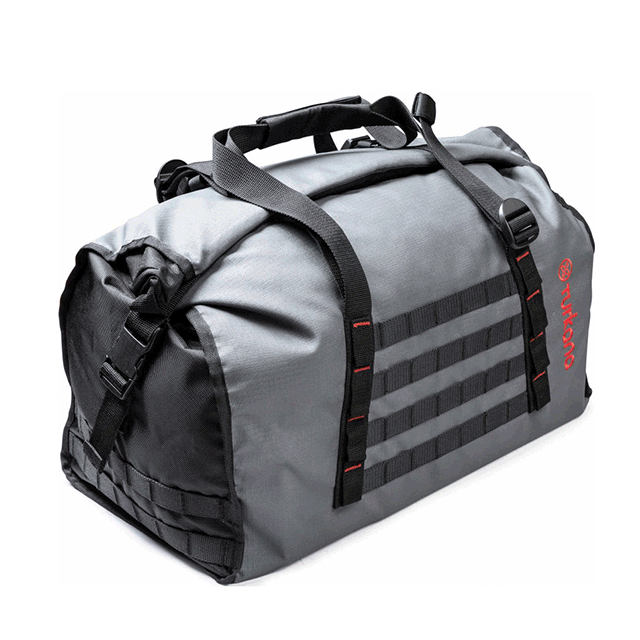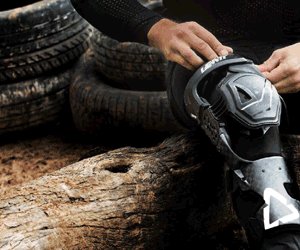“I was a backpacker and traveler first, and that led me into motorcycles. I left home pretty young and spent a few years bumming around, hitchhiking and riding freight trains all over the western US. When I was around nineteen, I got a Honda CB 550 and started using that instead of my thumb. Then I started doing international backpacking trips, and quickly figured out a bike was a lot more fun than traveling by train and bus.” – Pete Day

Pete Day is the co-founder of Mosko Moto, the Washington State-based adventure and dual sport soft bag company known for its grassroots approach to making real-world gear for riders. Originally from Philadelphia, he now lives in the Columbia River Gorge in a small town called Bingen. “I started my career in finance in Seattle, managed a consumer product design/manufacturing business in Eugene, Oregon before starting Mosko Moto.” Pete gave up on using hard luggage a long time ago. “I was sick of coming back from every trip with broken latches and dented water-soaked aluminum cases. I was an early convert to soft luggage. A little over five years ago I was on a trip down to Panama, riding a lot of off-road along the way, and using soft luggage. Living out of those bags for three months, and comparing them to backpacking gear I’ve owned, I noticed the complete lack of features, and also the floppy, clunky mounting system. It was sort of like a typical backpack from back before frame packs came along. I wondered whether a frame pack could work on a motorbike. I mentioned it to my buddy Andrew Bryden who was, at the time, the senior bag designer at DaKine. He rides too, and together we started brainstorming ideas for a frame-backed pannier. That concept eventually became the Backcountry 35 Pannier, our first product.”

The name Mosko comes from the Mosquito Coast, aka ‘La Moskitia.’ in the remote areas of Eastern Honduras and Nicaragua. “I was on a trip there and had a gnarly crash. I ended up leaving my KTM on a Honduran military base while I returned to the US for surgery. That happened just before we started Mosko. When it came time to test our first prototypes, I flew to Honduras, picked up the bike on the army base, and rode it down to Panama. That was the first extended trip that we used the bags on, so when it came time to pick a name for our new business a few weeks later, we liked the sound of Mosko.”

Mosko Moto is now in its 5th year of business. “Andrew and I first started talking about this idea in January 2013. We dedicated ourselves to it full time in November 2013. In May 2014 we attended our first motorcycle event, Overland Expo West, and showed our prototype bags to riders for the first time. We made our first shipments to customers in September 2014. That winter we started working with BMW to develop the Atacama luggage system, introduced to customers in 2016. In 2015 we also introduced a small run of the Reckless 40L / 80L system, which has now become one of our top sellers. In 2017, after three years of work, we introduced the Nomad Tank Bag, which is the first hydration-capable adventure tank bag. In 2017 the BMW Atacama luggage system also expanded to BMW dealerships worldwide.”

“There were all the usual startup business challenges. Like getting money and finding a factory. The decision to only sell directly to consumers had a huge impact on our business because, without dealers and distributors, it was far from certain how or ‘if’ riders would find us. We had designed this incredibly complex product that was way too expensive to sell through retail. If we had tried to sell it through retailers, it would’ve cost nearly twice the next most expensive system on the market. We had a great product, but no distribution. As it turned out though, there’s a very active community of riders online who pay a lot of attention to new tech and new products, and those riders have a lot of people who listen to them. Once those key early adopters got their hands on the gear, tested it, and were stoked, a snowball effect started. For a company with no dealers or distributors, I’m always amazed when I meet someone, and they already know who we are.”

May of 2014 was the first time Pete and Andrew showed their prototypes to anyone. “Up until then, Mosko had just been Andrew, me and our buddy Chip, who is a professional sewer and sailmaker, toiling away in Chip’s shop for nearly a year making samples. In late April we got our first prototypes from the factory, and we took them to Moab with some friends to go riding for a week. Then from Moab, we drove down to Overland Expo, an event we’d only heard about a few weeks before. We showed up with some dirty prototypes, bought a little shade structure at REI, and got some hay bails and tree stumps to give our ‘booth’ some personality. The first day we met a bunch of people and talked a lot but didn’t get any orders. We were like, ‘yeah, hey, that was cool, people seem to like the bags!’ Then the next morning Andrew said ‘hey, I just got an order!’ We were all excited. Then we got another order, and then another. When the show was over we sat in my camper and totaled everything up and were like whoa… this is legit… we’re in business!!

Pete has kept the Mosko product line intentionally small. “We try to put a lot of thought into every new product. We have about 20 main items. But when you include all the sub-items that make up the various kits we sell online, we actually have hundreds of individual SKUs in inventory. We want to keep the line focused, and have regular version updates to existing products rather than keep the product line growing endlessly.” Each main item in the Mosko lineup has a backstory and a history that represents years of development, testing and input from riders. “I can associate various testing trips with literally every single bag we make. So there are a lot of memories there. Riding through the Mosquito Coast with the original Backcountry 35. Or camping with Andrew in Moab and trying to make a heat shield for the Reckless 80 out of a crushed soup can. Or the first ‘concept’ trip for the Nomad when we strapped a hydration backpack to the tank of my little Russian bike in Vietnam. Everything is a work in progress. I think we’re getting close to a point where, rather than introducing new items all the time, we focus mostly on improving existing products. I’d prefer to have a small line of best-in-class items versus a sprawling assortment of items that hardly ever see updates. We only have so much development time, it’s our scarcest resource, and we have to use it wisely.

And when asked about what the future holds for the homegrown brand; “We’ve been working on riding apparel for like three years now. I’m sure people are getting tired of hearing about it, but it’s happening though! We’re committed to it, but we’re taking our time. There is a lot of good gear on the market already, we’re not in a hurry, and we want to do something unique. So in addition to new bags and improvements to existing bags, keep an eye out for a Mosko Jacket and pants in 2019.”





Leave a Reply